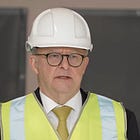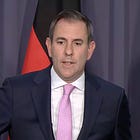Australian wage growth holds steady at 3.4% annually

Australia's wage growth trajectory has hit a telling inflection point, with annual increases holding steady at 3.4% while the underlying dynamics reveal a more nuanced story about economic momentum and worker compensation trends across the nation's labor market.
The details:
Quarterly movement: Wage Price Index rose 0.8% in June quarter 2025, down from 0.9% in March quarter
Annual growth: 3.4% year-over-year, unchanged from previous quarter but significantly below the 4.1% recorded in June 2024
Sector breakdown: Private sector wages grew 3.4% annually, while public sector wages increased 3.7%
Distribution shift: Fewer jobs received wage increases greater than 4%, contributing to overall moderation
Public sector drivers: Backdated pay rises from state enterprise agreements boosted quarterly public sector growth to 1.0%
Why it matters: This wage growth plateau signals Australia's labor market is transitioning from the post-pandemic recovery phase into a more normalized economic environment. The decline in high-percentage wage increases suggests employers are regaining negotiating leverage as labor market tightness eases, potentially indicating broader economic cooling.
Truth matters. Quality journalism costs.
Your subscription to The Evening Post (Australia) directly funds the investigative reporting our democracy needs. For less than a coffee per week, you enable our journalists to uncover stories that powerful interests would rather keep hidden. There is no corporate influence involved. No compromises. Just honest journalism when we need it most.
Not ready to be paid subscribe, but appreciate the newsletter ? Grab us a beer or snag the exclusive ad spot at the top of next week's newsletter.
The narrowing gap between private and public sector wage growth reflects stabilizing employment conditions across both sectors. However, the 3.4% annual increase remains above long-term historical averages, suggesting workers are still capturing some inflation-adjusted gains despite the deceleration.
For monetary policy, this data supports the Reserve Bank's cautious approach to interest rate adjustments, as wage growth remains elevated enough to sustain consumer spending without triggering aggressive inflationary pressures.
Bottom line: Australian wage growth is entering a mature phase of the economic cycle, with moderation reflecting normal market dynamics rather than economic distress. The 3.4% annual increase represents a sustainable pace that balances worker compensation gains with business cost management.
The shift toward fewer high-percentage wage increases suggests Australia's labor market is achieving better equilibrium between supply and demand. This trend will likely continue as economic conditions normalize, with wage growth expected to stabilize around current levels through the remainder of 2025.
Got a News Tip?
Contact our editor via Proton Mail encrypted, X Direct Message, LinkedIn, or email. You can securely message him on Signal by using his username, Miko Santos.
As well as knowing you’re keeping Mencari (Australia) alive, you’ll also get:
Get breaking news AS IT HAPPENS - Gain instant access to our real-time coverage and analysis when major stories break, keeping you ahead of the curve
Unlock our COMPLETE content library - Enjoy unlimited access to every newsletter, podcast episode, and exclusive archive—all seamlessly available in your favorite podcast apps.
Join the conversation that matters - Be part of our vibrant community with full commenting privileges on all content, directly supporting The Evening Post (Australia)
Not ready to be paid subscribe, but appreciate the newsletter ? Grab us a beer or snag the exclusive ad spot at the top of next week's newsletter.











